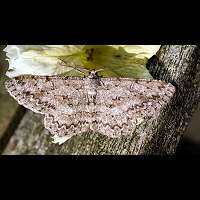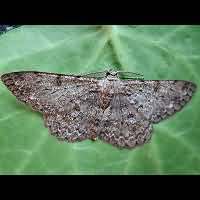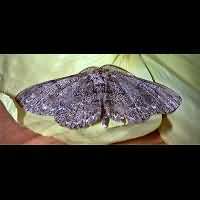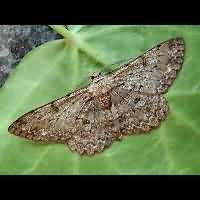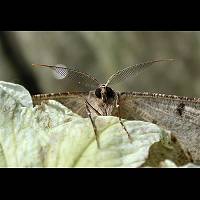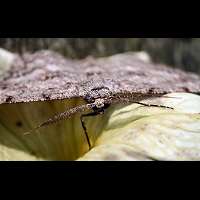Pale Oak Beauty (Hypomecis punctinalis)
Our eyes are having difficulties to see the exact pattern of waves and dots on the wings of many of the beauties. This is true for the Pale Oak Beauty as well. The main characteristic is half way on the lower wings: a clear ringlet shape. The upperwing however usually is in the way, so missing this sign is easy. Compared to other beauties the Pale Oak Beauty is often marked more vaguely and at first sight gives you the impression of a large, greyish moth. Looks very much like the Great Oak Beauty, but usually smaller and with sharp edges in the white line near the edge of the wing, which is more wavy and often less prominent in the Great Oak Beauty. Animals found in April, May or even the beginning of June usually are Pale Oak Beauties, for the Great Oak Beauty is on the wing in summer only. The wingspan runs from 45 to 58 mm. Often the animals give the impression of being bigger, because of the broad, large wings.
The eggs are being laid in summer and the caterpillar usually feeds at night. During daytime they assume the 'twig' position and are hard to discover. They really do look like a twig very much: light brown with some lighter speckles and blobs and a bud like swelling just before the center of the body. In autumn the larvae drop to the ground, dig a little hole and pupate inside. Winter is spend in that way. The caterpillar may be found on a great number of broad-leaved trees and shrubs, including hazel, birch, oak, apple. Sometimes even reported from Larch.
The Pale Oak Beauty is on the wing for a long time, especially in southern England where a partial second generation occurs regularly. Usually the first appear by the end of April and the numbers increase to the end of July. Continues to be on the wing in ever decreasing number to the end of August. Flying about by night exclusively, it is visible when resting on tree trunks or fences during the day. It is easily attracted to light, often in great numbers. The Pale Oak Beauty feels at home where ever trees are present in some numbers, including parks and gardens. It is a species of the moderate zone, common in England and parts of Wales, but not in Scotland. A typical species of Central Europe, not to be found in the north nor the Mediterranean.
Scientifically also known as Serraca punctinalis.
Our eyes are having difficulties to see the exact pattern of waves and dots on the wings of many of the beauties. This is true for the Pale Oak Beauty as well. The main characteristic is half way on the lower wings: a clear ringlet shape. The upperwing however usually is in the way, so missing this sign is easy. Compared to other beauties the Pale Oak Beauty is often marked more vaguely and at first sight gives you the impression of a large, greyish moth. Looks very much like the Great Oak Beauty, but usually smaller and with sharp edges in the white line near the edge of the wing, which is more wavy and often less prominent in the Great Oak Beauty. Animals found in April, May or even the beginning of June usually are Pale Oak Beauties, for the Great Oak Beauty is on the wing in summer only. The wingspan runs from 45 to 58 mm. Often the animals give the impression of being bigger, because of the broad, large wings.
The eggs are being laid in summer and the caterpillar usually feeds at night. During daytime they assume the 'twig' position and are hard to discover. They really do look like a twig very much: light brown with some lighter speckles and blobs and a bud like swelling just before the center of the body. In autumn the larvae drop to the ground, dig a little hole and pupate inside. Winter is spend in that way. The caterpillar may be found on a great number of broad-leaved trees and shrubs, including hazel, birch, oak, apple. Sometimes even reported from Larch.
The Pale Oak Beauty is on the wing for a long time, especially in southern England where a partial second generation occurs regularly. Usually the first appear by the end of April and the numbers increase to the end of July. Continues to be on the wing in ever decreasing number to the end of August. Flying about by night exclusively, it is visible when resting on tree trunks or fences during the day. It is easily attracted to light, often in great numbers. The Pale Oak Beauty feels at home where ever trees are present in some numbers, including parks and gardens. It is a species of the moderate zone, common in England and parts of Wales, but not in Scotland. A typical species of Central Europe, not to be found in the north nor the Mediterranean.
Scientifically also known as Serraca punctinalis.

